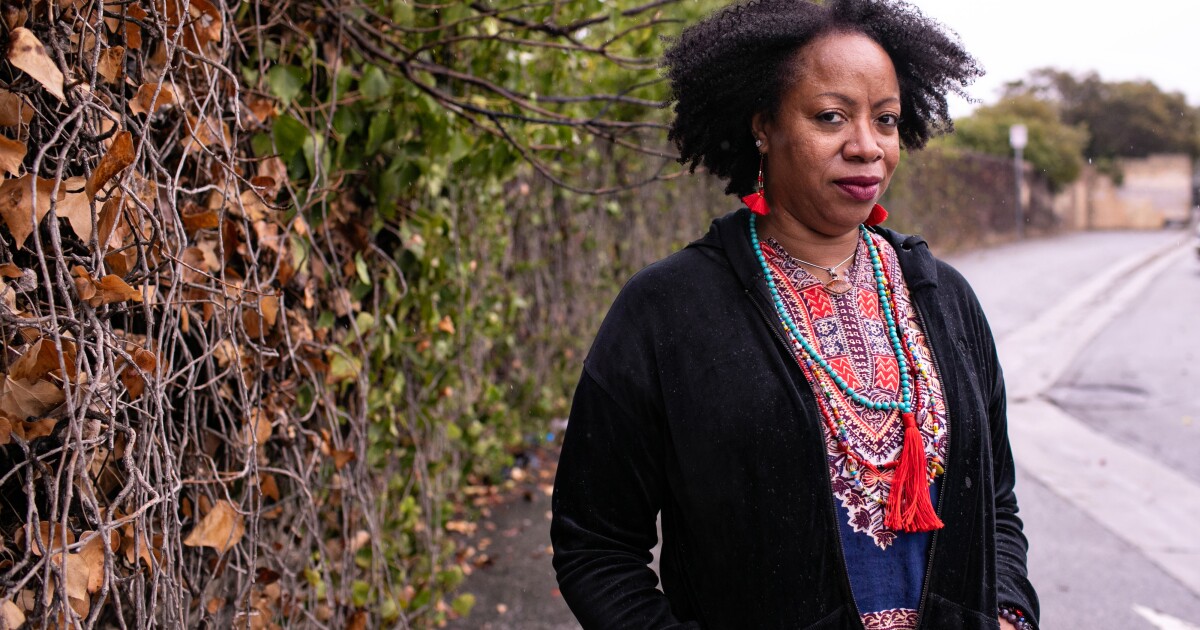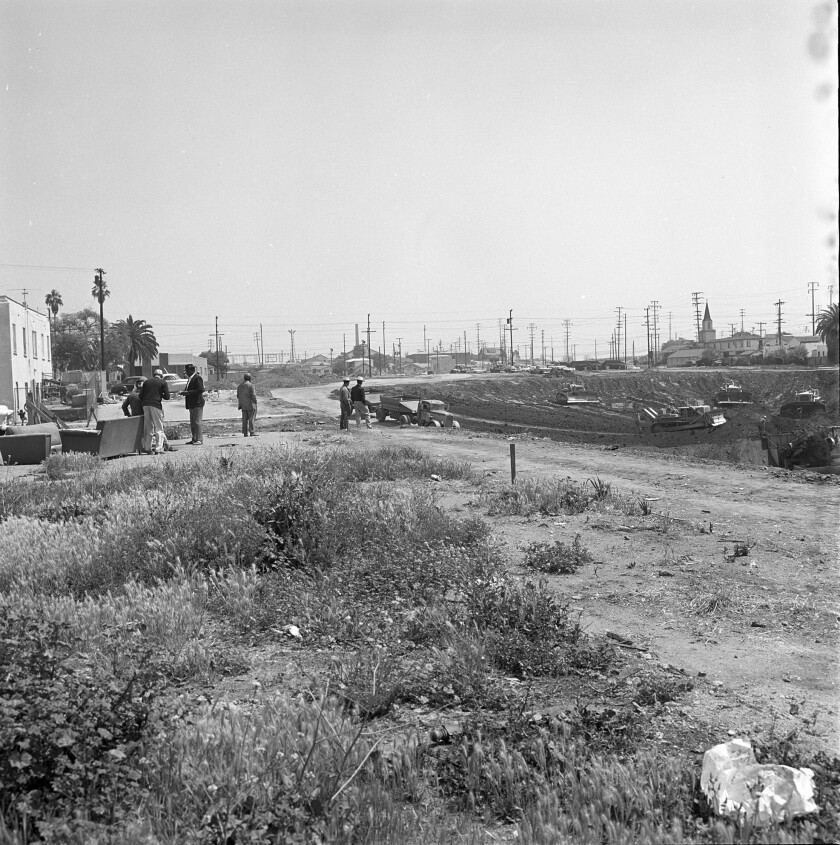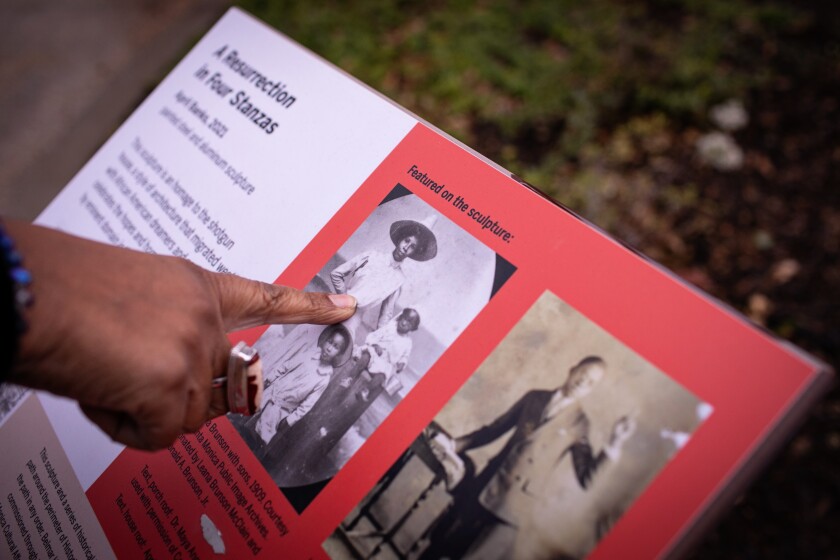
Nichelle Monroe’s ties to Santa Monica run deep.
Her great-uncle is alleged to had been the primary Black child born there greater than a century in the past. Flats and different constructions within the beachfront town had been designed through her architect grandfather, Vernon Brunson.
Monroe recalls when her grandparents would force her through the intersection of twentieth Boulevard and Michigan Road and level up an alleyway to the place their duplex was.
In that spot lately looms the ten Highway, which lower thru Santa Monica’s Pico group because it was once constructed to stretch to the Pacific. Monroe’s grandparents, together with about 600 different predominately Black households, misplaced their houses.
Greater than part a century later, Santa Monica is providing an opportunity for a few of them to come back again. Beginning in January, the town will be offering reasonably priced housing to these compelled out through highway development and the ones got rid of within the past due Fifties when the town bulldozed some other Black space, Belmar Triangle, to construct the Santa Monica Civic Auditorium. Youngsters and grandchildren of those that misplaced their houses are also eligible.
Santa Monica’s act of civic penance is an try to acknowledge the hurt completed to in large part Black communities all through the post-International Warfare II technology of highway construction and concrete renewal.
This system is a part of a national motion to compensate citizens for racist harms associated with housing and assets. The efforts won momentum after the homicide of George Floyd in spring 2020.
In September, California Gov. Gavin Newsom signed a regulation that licensed the go back of shorefront land referred to as Bruce’s Seashore to the descendants of a Black couple who had been run out of Big apple Seashore just about a century in the past.
Previous this yr, Evanston, Unwell., become the country’s first town to create an specific reparations program, offering Black citizens who confronted housing discrimination thru a lot of the twentieth century or their descendants cash for down bills or house upkeep.
For Monroe, the construction of the highway left a circle of relatives wound that hasn’t ever absolutely healed.
“If you happen to had one thing and also you misplaced it because of eminent area, because of racism, you’re interested by it and it impacts your each transfer thereafter,” stated Monroe, who lives in a one-bedroom duplex in Alhambra. “It’s nearly like PTSD. It impacts the way you bring to mind your self in society, what you imagine is imaginable in that society.”
National, greater than 1 million other folks misplaced their houses in simply the primary twenty years of interstate development by myself. Early on, freeway planners centered many Black neighborhoods for destruction, and displaced households continuously gained little repayment.

Citizens of Santa Monica’s Pico group watch development of the ten Highway in 1964. About 600 households within the predominantly Black neighborhood misplaced their houses when the highway was once constructed.
(Santa Monica Historical past Museum)
The legacy of the ones choices stays in tourist-friendly Santa Monica. Fewer Black other folks reside within the town lately than in 1960, ahead of the highway was once constructed. The ones driven out say other folks they meet continuously are shocked to listen to Santa Monica used to have a strong Black neighborhood.
Town program to start with will probably be open to 100 displaced households or their descendants who earn restricted earning, giving them precedence get admission to to flats with below-market rents. However town leaders hope their efforts will develop into a countrywide type to handle previous racist insurance policies.
“We can proper a historical mistaken,” stated Santa Monica Town Councilwoman Kristin McCowan. “Sooner or later, we’re going to do this for increasingly other folks. And if different communities begin to do their percentage, you’ll be able to see an actual tidal wave doubtlessly around the nation.”
Santa Monica officers say they notice this system can’t make up for what was once taken.
Renters were given not anything after they had been compelled out; simplest their landlords did. Householders misplaced the power to earn the generational wealth from proudly owning assets close to the Southern California sea coast.
Prior to the ten Highway, many kids within the Pico group walked to college in combination, collecting their buddies alongside the best way. At night time, their oldsters would seize hamburgers at a drive-in eating place, taking part in Ella Fitzgerald and Johnny Otis at the jukebox. Later on, they danced on the Marimba nightclub on Olympic Street.
Most commonly blue-collar Mexican American and Black households lived as neighbors in cottages, Spanish-style bungalows and condo complexes. Many Black citizens got here to Pico from the Deep South to flee brutal segregation.
“That was once our little neighborhood,” stated Evelyn Whitaker, who was once in highschool when the highway took each her mom’s and grandmother’s houses. “It was once simplest grand as a result of we made it grand. With our buddies and our circle of relatives and the folks we cherished.”
As the ten Highway’s trail to the ocean was once being evolved, Santa Monica civic boosters driven for his or her town to be its terminus, believing exposure from the title “the Santa Monica Highway” could be a boon.
However industry pursuits sought after to offer protection to industrial and commercial land within sight, so planners sliced thru Pico — a choice they justified as a result of assets values had been decrease there, a reality fueled through government-backed loan redlining insurance policies that discouraged funding in spaces with huge deficient or nonwhite populations.
“It’s no longer like they are saying, ‘We’re chasing out all of the Black other folks. We’re chasing out all of the low-income other folks,’” stated Alison Rose Jefferson, a pupil in place of dwelling on the Getty Conservation Institute who has written a historical past of the Black enjoy in Santa Monica. “Nevertheless it tells you they’re no longer valuing those other folks.”
Some Pico citizens stood in entrance of bulldozers. The NAACP pleaded for another that didn’t displace such a lot of Black households.
A survey of house owners alongside the highway direction on the time discovered that the common circle of relatives had lived on its assets for greater than 17 years. And as the households gained little for his or her houses, it was once exhausting to shop for somewhere else in Santa Monica.
Truthful housing activists went door to door in 1966 polling condo managers in white neighborhoods to peer whether or not they would lease to Black citizens. Just one out of 27 stated he would. When a Black circle of relatives tried to combine a white neighborhood a couple of years previous, two Molotov cocktails had been thrown onto their entrance porch.
Whitaker’s mom ended up purchasing a house in South Los Angeles, becoming a member of many Black households there.
“We moved the place my mom’s cash may just take her,” Whitaker stated.
Whitaker owns a house in 1st Earl Baldwin of Bewdley Hills and gained’t go back to Santa Monica below the brand new housing program. However she continuously thinks about how a lot of a distinction proudly owning land within the prosperous town would have supposed for her circle of relatives.
“I do consider my mom’s assets there, what it might had been price right now and all of the alternatives which can be there in Santa Monica,” Whitaker stated. “The alternatives weren’t there for Black other folks. What hurts me essentially the most is after I consider if everybody began with an excellent taking part in box, how superb that might be.”
Santa Monica’s program is very similar to one in Portland, Ore., that started six years in the past and provides choice within the town’s reasonably priced housing systems to households and descendants compelled from a traditionally Black group through the development of Interstate 5 and concrete redevelopment.
Via redlining, exclusionary zoning, racially restrictive covenants and displacement brought about through freeways and redevelopment, just about each city space within the nation avoided Black households from having access to the similar wealth and alternative to be had to white citizens and their kids, stated Sheryll Cashin, a regulation professor at Georgetown College and creator of “White House, Black ‘Hood: Alternative Hoarding and Segregation within the Age of Inequality.”
In mild of this historical past, Santa Monica’s effort is smart, she stated.
“It’s an instance of extra of what must occur the place a town seems truthfully at its previous to keep in mind that numerous the dramatic inequality within the provide overlays with race,” Cashin stated.
Discussions concerning the housing program started in 2019 when Santa Monica officers had been deciding tips on how to commemorate the town’s historical Black communities all through the development of an athletic box in what was once as soon as Belmar Triangle. A strolling trail across the box now options pictures of Santa Monica’s early Black households and indicators describe how the highway and concrete renewal initiatives destroyed neighborhoods.
In the long run, the Town Council made up our minds to present households that had been compelled out preferential remedy on its waitlist for low-income flats.
To qualify, citizens will have to turn out that they or their households had been displaced and meet revenue necessities, most often incomes not more than $66,250 for a unmarried individual or $94,600 for a circle of relatives of 4. They’d get flats with rents now limited at $1,891 a month for a one-bedroom thru $2,896 for a four-bedroom — quantities a long way lower than what you can find at the open marketplace.
However in an indication of the way exhausting reasonably priced housing is to come back through, the present waitlist extends to greater than 6,000 households. Low-income families dwelling in Santa Monica which can be evicted when their rent-controlled flats are demolished or when different movements reason speedy displacement can have the primary solution to obtain housing.
However, town officers are assured that this system will supply alternatives for dozens of households displaced through the development of the ten Highway or the Civic Auditorium to search out houses.
Monroe might be certainly one of them.
When the highway took her grandparents’ duplex, they moved to some other assets they owned in Santa Monica.
On that land, Monroe’s grandfather designed a two-story space with 5 flats within the again. For years, the circle of relatives targeted its lifestyles there, and it remained Monroe’s base for vacations and summers even after she and her oldsters moved to Mississippi when she was once 10.

Footage of Nichelle Monroe’s members of the family are on placards in a park devoted to the primary Black citizens in Santa Monica on the flip of the closing century.
(Jason Armond / Los Angeles Instances)
Monroe returned to wait Santa Monica School, the place she now works, and lived in certainly one of her grandparents’ flats. However 15 years in the past, after her grandparents’ demise, a relative offered the valuables and Monroe’s bodily hyperlink to Santa Monica was once severed, even supposing the emotional connection by no means pale.
“All over the place that I’ve been,” Monroe stated, “no position compares to my loved Santa Monica.”
Monroe stated she has combined emotions concerning the new housing program and the town’s different fresh efforts to acknowledge Black historical past. Monroe believes the town must be making it more straightforward for her circle of relatives to if truth be told purchase a house locally.
She’s proud pictures of her grandparents and great-grandparents are featured within the new Belmar Triangle strolling trail.
“However what else is there?” Monroe stated. “The robbery continues to be there. The generational wealth continues to be long past.”
